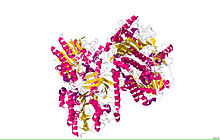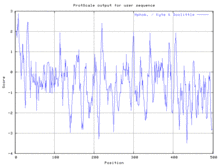- Arylsulfatase B
-
arylsulfatase B 
Crystallographic structure of putative tetrameric arylsulfatase from Escherichia coli.[1] Identifiers Symbol ARSB Entrez 411 HUGO 714 OMIM 253200 RefSeq NM_000046 UniProt P15848 Other data EC number 3.1.6.12 Locus Chr. 5 p11-q13 Arylsulfatase B (ARSB) is an enzyme associated with mucopolysaccharidosis VI.
Arylsulfatase B is among a group of arylsulfatase enzymes present in the lysosomes of the liver, pancreas, and kidneys of animals. The purpose of the enzyme is to hydrolyze sulfates in the body. ARSB does this by breaking down Glycosaminoglycans(GAGs), which are large sugar molecules in the body. ARSB targets two GAGs in particular: dermatan sulfate and chondroitin sulfate[2].
Over 130 mutations to ARSB have been found, each leading to a deficiency in the body. In most cases, the mutation occurs on a single nucleotide in the sequence. An arylsulfatase B deficiency can lead to an accumulation of GAGs in lysosomes[2], which in turn can lead to Maroteaux–Lamy syndrome, or mucopolysaccharidosis VI.
Contents
Structure
The primary structure of Escherichia coli arylsulfatase B contains a primary sequence of 502 amino acids. Its secondary structure is quite complex, containing numerous alpha helices (20 total containing 138 residues) and beta sheets (21 strands total containing 87 residues).[1] The functional enzyme is believed to be a homo tetramer. Due to the complexity of arylsulfatase B's secondary structure, many hydrophobic and hydrophilic regions are present, as demonstrated by the Kyte-Doolittle hydropathy plot:
Additional structural data is shown in Ramachandran analysis plots at: http://www.rcsb.org/pdb/images/3ED4_ram_m_500.pdf.
See also
References
- ^ a b PDB 3ED4; Patskovsky Y, Ozyurt S, Gilmore M, Chang S, Bain K, Wasserman S, Koss J, Sauder MJ, Burley SK, Almo SC (2010). "Crystal structure of putative arylsulfatase from Escherichia coli". To be Published. doi:10.2210/pdb3ed4/pdb.
- ^ a b U.S. National Library of Medicine. "ARSB", Genetics Home Resource, November 7, 2010, Retrieved November 22, 2010
External links
- Medical Dictionary, Arylsulfatase B function.
- Protein Data Base (PDB), Arylsulfatase structure.
- Genetics Home Reference, Arylsulfatase B function.
glycosaminoglycan anabolism glycosaminoglycan catabolism Heparan sulfamidase · N-acetyltransferase · Alpha-N-acetylglucosaminidase · Glucuronidase · N-acetylglucosamine-6-sulfatase
This hydrolase article is a stub. You can help Wikipedia by expanding it.

